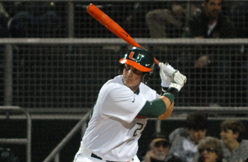We’ve gone surface level with our coverage of Yasmani Grandal up to this point, but now it’s time to go deeper. Our coverage to this point hardly qualifies as analysis, and that’s not a dig on us. There have been so many other aspects that needed analysis, Grandal has fallen through the cracks to this point. No more. It’s time for Grandal’s moment of glory. And let me assure you, there’s nothing more glorious than being the focus of an analysis piece here.
We can rehash Grandal’s prospect ranking all day, but I promised you substance. To get that, let’s start with his story.
While most American boys were concerned about Power Rangers and how far they could jump their bikes off ramps, Yasmani Grandal was waiting to find out his future. There are ways out of Cuba. Many of them are unpleasant and dangerous. But there was a simple method back in 1998, a method Grandal’s family took. They essentially asked the Cuban and United States governments for permission.
Fourteen years ago, Grandal’s family applied for and won a lottery (the Cuban Special Migration Program), and his entire family was allowed to defect to the United States. The program arose out of the U.S.-Cuban Migration Accords of 1994, and it allows Cuban nationals who otherwise would not qualify for asylum in the United States to participate in a lottery. The lottery winner is chosen randomly, as was the case with Grandal and his family. The program is no longer in existence today, and Grandal’s family was one of the last to be allowed to participate.
In a June 2010 article in the Palm Beach Post, Grandal said, “I think about what would have been if I stayed there.” Things certainly would have been different.
His is a rare tale of a chance at a better life without the inherent danger most Cuban defectors face. Rather than a life-threatening open-seas trip to Florida, Grandal and his family arrived with relative ease and safety in Florida. Grandal was ten years old at the time. He quickly went from a life in which he would go to sleep hungry to a life in which food was abundant, snacks were available, and life was easier.
“In Cuba, we woke up in the morning wondering what we were going to eat in the afternoon,” said Maria Gomez, who arrived in the U.S. on July 3, 1999 with husband Elieser, her parents and son Yasmani, now a star catcher for the University of Miami. “He got here where you could watch television all day in a nice air-conditioned house with tons of goodies to eat.”
Grandal adjusted nicely to the United States, built up his weight and began playing baseball. By June of 2010, as he waited to find out what Major League team would draft him out of the University of Miami, Grandal was 6′ 2″, weighing 210 pounds. He had become one of the best players in all of college baseball, a finalist for the Johnny Bench Award and the Golden Spikes Award.
Grandal struggled in his first two years of college ball hitting .234 and .299 respectively. However, his Junior year proved to be his breakout season. During that season, Grandal hit .422/.545/.754 with 14 home runs. And these were just his stats at the plate. Behind the plate, Grandal was just as good. In his final year with the Hurricaines, Grandal threw out 40% of the runners trying to steal against him. His arm will be as valuable as his bat at the Major League level.
The Cincinnati Reds took Yasmani Grandal 12th overall with the June 2010 draft. As we know, he spent two minor league seasons with the Reds’ organization before being sent to San Diego in the Mat Latos trade.
In his two minor league seasons, which spanned two different Rookie League teams followed by Single-A ball; Double-A ball; and Triple-A ball, Grandal struck out in 22% of his plate appearances, but walked in 13% of those appearances. He hit .303/.401/.488. He’s shown some pop hitting 14 home runs in 105 games in 2011, but his real talent is his ability to put the ball where the fielders aren’t. Part of his BAbip in the minor leagues is the lower-level fielding ability of many of the defenders, but much of Grandal’s numbers have to do with where he hits the ball. His 2011 BAbip with the Reds’ Single-A affiliate was .359 in 56 games. In 45 games with the Double-A affiliate, Grandal’s BAbip was .377. Obviously that number will come back close to .300 when he hits the Major Leagues, but the trend is promising. Grandal has been able to find the gaps throughout his minor league seasons. Over the course of 113 combined games, he has hit 32 doubles.
Behind the plate, Grandal threw out 34% of runners in his minor league career thus far. He had 19 passed balls in 2011, but just 5 combined between Double-A and Triple-A ball.
With Nick Hundley behind the play for 2012, and John Baker serving platoon duty, Grandal will likely start the season in Triple-A Tucson. He has a shot at a September call-up, but barring any injuries to the Major League roster, Grandal is more likely to see a 2013 call-up. The Padres have opened up their options behind the plate. Hundley has been slowly building steam as a trade chip over the last season or so. With Grandal waiting in the wings, it makes it easier for the Padres to consider a trade.
Whether we see Grandal in 2012 or 2013, the Padres seem very well-set in their catching situation with player who was selected to the 2010 Collegiate Baseball First Team and the All ACC First team, was a member of the 2009 United States National Team, and was a finalist for both the Johnny Bench Award and Golden Spikes Award.

(chickenfriars.com)



